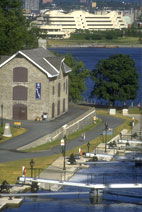 Fast Facts
Fast Facts
The currents of history flow through the Rideau Canal, operated by Parks Canada as a National Historic Canal. Dating back to the nineteenth century, the Canal links lakes and rivers for a distance of over 200 kilometres from Ottawa to Kingston. The Canal offers outdoor recreational activities in an historic and beautiful natural setting.
Did You Know?
- The Rideau Canal is North America's oldest operating 19th-century canal. Most of the locks are still cranked open by old-fashioned muscle power.
- The original purpose of the Rideau Canal was to provide a safe supply route between Montreal and the Great Lakes in case of attack by the United States.
- The canal was one of the greatest engineering feats of the 19th century requiring the construction of 24 dams and 46 locks.
- The area was a wilderness when the Canal was built despite the northern climate, many of the workers died from malaria in the mosquito-infested swamps.
- At the Ottawa River end of the Canal, head engineer, Lieutenant Colonel John By, founded a community called Bytown. It later changed its name to Ottawa and became the Capital of Canada.
- In the winter, the Ottawa portion of the Canal is made into a gigantic skating rink -- the largest in the world. Winterlude, a winter celebration orginated on the Rideau Canal.
An Historic Waterway
In the wake of the War of 1812, British North America feared attack from the United States. Engineers built the Rideau Canal between 1826 and 1832 as part of a secure supply route between Montreal and Kingston.
Today, the Canal appears much as it did over 150 years ago with limestone locks, hand-operated cranks, wooden lock master houses, and stone supply buildings. Parks Canada presents exhibits and programs which tell of the amazing feats of the canal builders and the evolution of the Canal from military route to recreational waterway.
A Waterway for All to Enjoy
Today, the Rideau Canal is one of the Capital's most popular recreational areas. In the summer, canoes and motorboats ply the waters, while walkers, joggers, cyclists and in-line skaters enjoy the recreational pathways alongside. In the winter, 8 kilometers are cleared to become the largest outdoor ice-skating rink in the world.
Related Links

